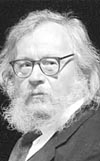|
AFTER THE GURU
BY STEPHEN NUNNS
Young Artists Confront Grotowski's Legacy
When
theatrical visionary Jerzy Grotowski died last month at 65, he left a long and
distinguished legacy. Obituaries lumped him with Stanislavsky and Brecht and likened the
Polish director to a Zen master. For a generation of experimental theater artists who came
of age in the '60s and '70s, the importance of Grotowski's work and teachings is
undeniable. Joseph Chaikin, the Living Theater, Mabou Mines, Andrei Serban, and Richard
Schechner are among many who made pilgrimages to Poland or worked with him during his
visits to the U.S.
But for
artists under the age of 45, it's a different story. They never saw his work, since the
Polish Laboratory Theater last performed in the U.S. in 1973, and the director stopped
doing traditional theater altogether in the mid '70s. Their connection to Grotowski is
second- or thirdhand: Maybe they were exposed to his teaching methods in an undergraduate
theater course— remember the infamous cat-stretch exercise?— or heard André
Gregory's rather bizarre account of one of the director's later "paratheatrical
encounters" in a Polish forest in the film My Dinner With André.
Most
members of the younger generation found out about Grotowski by thumbing through his
long-out-of-print collection of essays, Towards a Poor Theater. They read about his belief
in a "holy" theater— work that was spiritual and ritualistic. They probably
also read such solemn platitudes as "We can define the theater as what takes place
between the spectator and actor. All the other things are supplementary. The 'Rich
Theater' [that is, most Western theater that is not Grotowski's] depends on artistic
kleptomania, drawing from other disciplines, constructing hybrid-spectacles [and]
conglomerates without backbone."
These
sentiments may have had resonance in the '60s, but in our high-tech, image-driven,
short-attention-span world they sound, well, a little quaint. In an atmosphere where many
younger artists look to the television monitors of the Wooster Group or the tape loops of
Richard Foreman for inspiration, it's hard not to think that Grotowski's Poor Theater may
belong to an older, gentler time.
"When
I survey the scene in the last decade," says Target Margin director David Herskovitz,
"a lot of the interesting things don't have a hell of a lot to do with him. And the
idea that the encounter between the actor and the audience is the essential element is not
exactly a view I share. You could say that what's essential is presenting a text in a
faithful way. Or you could also argue that the core of the theatrical experience can be a
bunch of different elements— sound, video, actors, whatever— that are put
together for an orchestral effect.
"That
austere approach can be a beautiful thing," the director continues, "but as an
artistic matter, it's rather hermetic. At its worst, it can be annoying and inspire a kind
of zealotry. Obviously, Grotowski agreed, because at a certain point he just quit."
"I
agree with his idea that all you need is an actor— that theater's about the
connection between the performer and the audience," says Anne Dudek, the 23-year-old
star of the recently closed Iphigenia Cycle, directed, coincidentally, by onetime
Grotowski student JoAnne Akalaitis. "I'm an actor, so naturally I believe that's the
important thing. But still, there's nothing wrong with establishing a good balance. All
this technology we have at our fingertips— video, lighting, sound— are just
elements that assist the actor."
It's also
obvious that in the '90s, Poor Theater is not really a choice at all, but an unfortunate
necessity to younger artists. Rather than embrace the poverty (after all, how many times
have you sat through shows on the Lower East Side where the main technical elements were
clip lights and Duvatene?), many do everything they can not to let their work look
"poor." That distresses playwright Ruth Margraff. "I see this thing in
experimental theater a lot where there's this supposed elegance to it," she says.
"The thing is, work that's more ragged and raw is a lot more difficult to stomach.
It's like watching a bum come up and ask for money. Still, I love that ragged
poverty."
And where
can you see that kind of ratty energy nowadays? "Maybe with the punk kids on St.
Mark's Place," she says. "Not in a theatrical setting, that's for sure."
Still,
there's something attractive about Grotowski's theories, particularly in as cynical a
climate as the contemporary New York theater environment. "People have this reaction
to Grotowski, like, 'Oh, that's just therapy, and therapy is indulgent,' " says actor
Steve Ratazzi, who once studied with Ryszard Cie´slak, Grotowski's principal actor.
"As if it's all bullshit. But it's not. It's about process. And unfortunately, the
New York theatrical scene is very antiprocess right now."
In this
kind of atmosphere, Grotowski's naive belief in the passion and the "holiness"
of the art can seem not only invigorating, but downright radical. "Don't get me
wrong," says playwright C.J. Hopkins, "I don't care for gurus of any stripe, and
I don't believe in secret mysteries, but I do believe there is such a thing as the sacred.
I do think that the world is changed in our every act. And any artist who attempts to
remind us of that, regardless of whatever pretentious horse dung he leaves in his wake,
has contributed something important."
|
